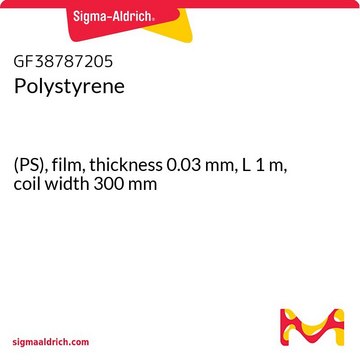Wszystkie zdjęcia(3)
Kluczowe dokumenty
331651
Polystyrene
average Mw 35,000
Synonim(y):
PS
Zaloguj sięWyświetlanie cen organizacyjnych i kontraktowych
About This Item
Wzór liniowy:
[CH2CH(C6H5)]n
Numer CAS:
Numer MDL:
Kod UNSPSC:
12162002
Identyfikator substancji w PubChem:
NACRES:
NA.23
Polecane produkty
Formularz
beads or pellets
masa cząsteczkowa
average Mw 35,000
temp. przejścia
softening point (ASTM E 28) 123-128 °C
gęstość
1.06 g/mL at 25 °C
InChI
1S/C8H8/c1-2-8-6-4-3-5-7-8/h2-7H,1H2
Klucz InChI
PPBRXRYQALVLMV-UHFFFAOYSA-N
Szukasz podobnych produktów? Odwiedź Przewodnik dotyczący porównywania produktów
Opis ogólny
Polystyrene is a high molecular weight synthetic polymer made from the polymerization of styrene. It is durable, thermoplastic, and hydrophobic in nature.
Zastosowanie
Polystyrene(PS) can be used as a precursor to synthesize dye-doped fluorescent PS nanoparticles, which can be applied in the field of optical microscopy, cell tracking, and optical sensors.
It can be used to stabilize the perovskite component by forming PS-capped perovskite grains. This PS coverage can suppress the organic component evaporation, and water corrosion and promotes crystal self-healing of perovskite films.
Due to its optical clarity, low production cost, and ease ofmanufacture, it is widely used as a fundamental substrate for in vitrocell culture.
It can be used to stabilize the perovskite component by forming PS-capped perovskite grains. This PS coverage can suppress the organic component evaporation, and water corrosion and promotes crystal self-healing of perovskite films.
Due to its optical clarity, low production cost, and ease ofmanufacture, it is widely used as a fundamental substrate for in vitrocell culture.
Cechy i korzyści
- Thermal efficiency
- Durability
- Moisture resistance
Postać fizyczna
Bimodal.
Ta strona może zawierać tekst przetłumaczony maszynowo.
Kod klasy składowania
11 - Combustible Solids
Klasa zagrożenia wodnego (WGK)
WGK 3
Temperatura zapłonu (°F)
Not applicable
Temperatura zapłonu (°C)
Not applicable
Środki ochrony indywidualnej
Eyeshields, Gloves, type N95 (US)
Wybierz jedną z najnowszych wersji:
Masz już ten produkt?
Dokumenty związane z niedawno zakupionymi produktami zostały zamieszczone w Bibliotece dokumentów.
Klienci oglądali również te produkty
Hiroyuki Yanagisawa et al.
Molecules (Basel, Switzerland), 23(4) (2018-03-23)
This study was conducted with the aim of achieving the simultaneous screening of various additives in polymer materials by utilizing a solvent-free pyrolyzer/thermal desorption gas chromatography mass spectrometry (Py/TD-GC-MS) method. As a first step to achieve this goal, simultaneous screening
Prasert Akkaramongkolporn et al.
AAPS PharmSciTech, 10(2), 641-648 (2009-05-20)
The differently sulfonated styrene-divinylbenzene cross-linked copolymer cationic exchange resins were prepared by oil-in-water polymerization and varied degrees of sulfonation. Several characteristics of the obtained resins were evaluated, i.e., Fourier transform infrared spectra, the ion-exchange capacity, microscopic morphology, size, and swelling.
Hui Xia et al.
Journal of colloid and interface science, 376(1), 322-326 (2012-03-27)
The aggregation kinetics of particles in dense polystyrene latex suspensions is studied by low-coherence fiber optic dynamic light scattering. Low-coherence fiber optic dynamic light scattering is used to measure the hydrodynamic radius of the aggregates. The aggregation kinetics data obtained
Harikrishnan Narayanan Unni et al.
Electrophoresis, 30(5), 732-741 (2009-03-05)
This study reports a theoretical and experimental study on the irreversible deposition of colloidal particles from electrokinetic microfluidic flow. The electrokinetic particle transport model presented in this study is based on the stochastic Langevin equation, incorporating the electrical, hydrodynamic, Derjaguin-Landau-Verwey-Overbeek
Iván A Hinojosa et al.
Marine pollution bulletin, 58(3), 341-350 (2009-01-07)
Floating marine debris (FMD) is reported from all oceans. The bulk of FMD are plastics, which due to their longevity cause multiple negative impacts on wildlife and environment. Identifying the origins of FMD (land- or sea-based) is important to take
Nasz zespół naukowców ma doświadczenie we wszystkich obszarach badań, w tym w naukach przyrodniczych, materiałoznawstwie, syntezie chemicznej, chromatografii, analityce i wielu innych dziedzinach.
Skontaktuj się z zespołem ds. pomocy technicznej


